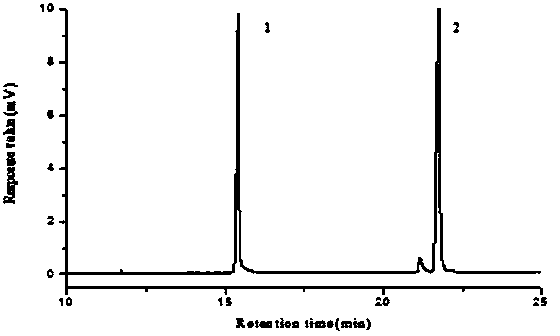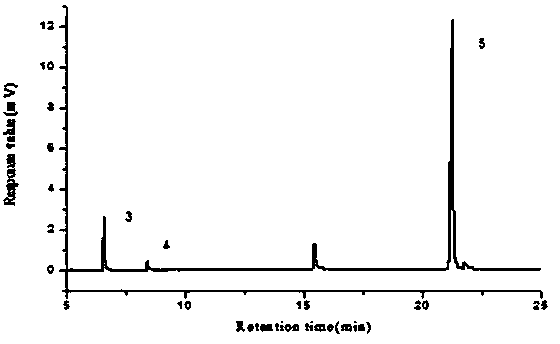Co-detection method for trace organic impurities in complex water sample
A technology of organic impurities and detection methods, applied in the field of environmental detection, can solve tedious and time-consuming problems
- Summary
- Abstract
- Description
- Claims
- Application Information
AI Technical Summary
Problems solved by technology
Method used
Image
Examples
Embodiment 1
[0015] Prepare a mixed aqueous solution of phenol and m-cresol in a 50 mL volumetric flask, the concentration of phenol is 3.06 mg / L, and the concentration of m-cresol is 0.10 mg / L. After mixing evenly, take 4 mL of the mixed solution in the extraction bottle, add a stirring bar, Stir at 40°C for 20 min, take out the solid-phase microextraction device, place it in the gas chromatographic inlet, perform high-temperature thermal desorption and detect it in the gas chromatograph, the chromatogram is as follows figure 1 shown.
Embodiment 2
[0017] Prepare mesityl oxide, 3-methylcyclopentanone, and acetophenone aqueous solution in a 50 mL volumetric flask, the concentration of mesityl oxide is 0.08 mg / L, the concentration of 3-methylcyclopentanone is 0.09 mg / L, The concentration of acetophenone is 0.21 mg / L. After mixing evenly, take 4 mL of the mixed solution into the extraction bottle, add a stirring bar, stir at 40°C for 20 min, take out the solid-phase microextraction device, and place it in the gas chromatography inlet. After high-temperature thermal desorption, it is detected in gas chromatography, and its chromatogram is as follows: figure 2 shown.
Embodiment 3
[0019] Prepare phenol, m-cresol, mesityl oxide, 3-methylcyclopentanone, and acetophenone aqueous solution in a 50 mL volumetric flask, the concentration of phenol is 1.53 mg / L, and the concentration of m-cresol is 0.05 mg / L, The concentration of mesityl oxide is 0.04 mg / L, the concentration of 3-methylcyclopentanone is 0.05 mg / L, and the concentration of acetophenone is 0.11 mg / L. After mixing evenly, take 4 mL of the mixed solution in the extraction bottle, add Stirring bar, stirred at 40°C for 20 min, took out the solid-phase microextraction device, placed it in the gas chromatographic inlet, and carried out high-temperature thermal desorption and then detected it in the gas chromatograph. The chromatogram is as follows: image 3 shown.
PUM
| Property | Measurement | Unit |
|---|---|---|
| thickness | aaaaa | aaaaa |
Abstract
Description
Claims
Application Information
 Login to View More
Login to View More - R&D
- Intellectual Property
- Life Sciences
- Materials
- Tech Scout
- Unparalleled Data Quality
- Higher Quality Content
- 60% Fewer Hallucinations
Browse by: Latest US Patents, China's latest patents, Technical Efficacy Thesaurus, Application Domain, Technology Topic, Popular Technical Reports.
© 2025 PatSnap. All rights reserved.Legal|Privacy policy|Modern Slavery Act Transparency Statement|Sitemap|About US| Contact US: help@patsnap.com



